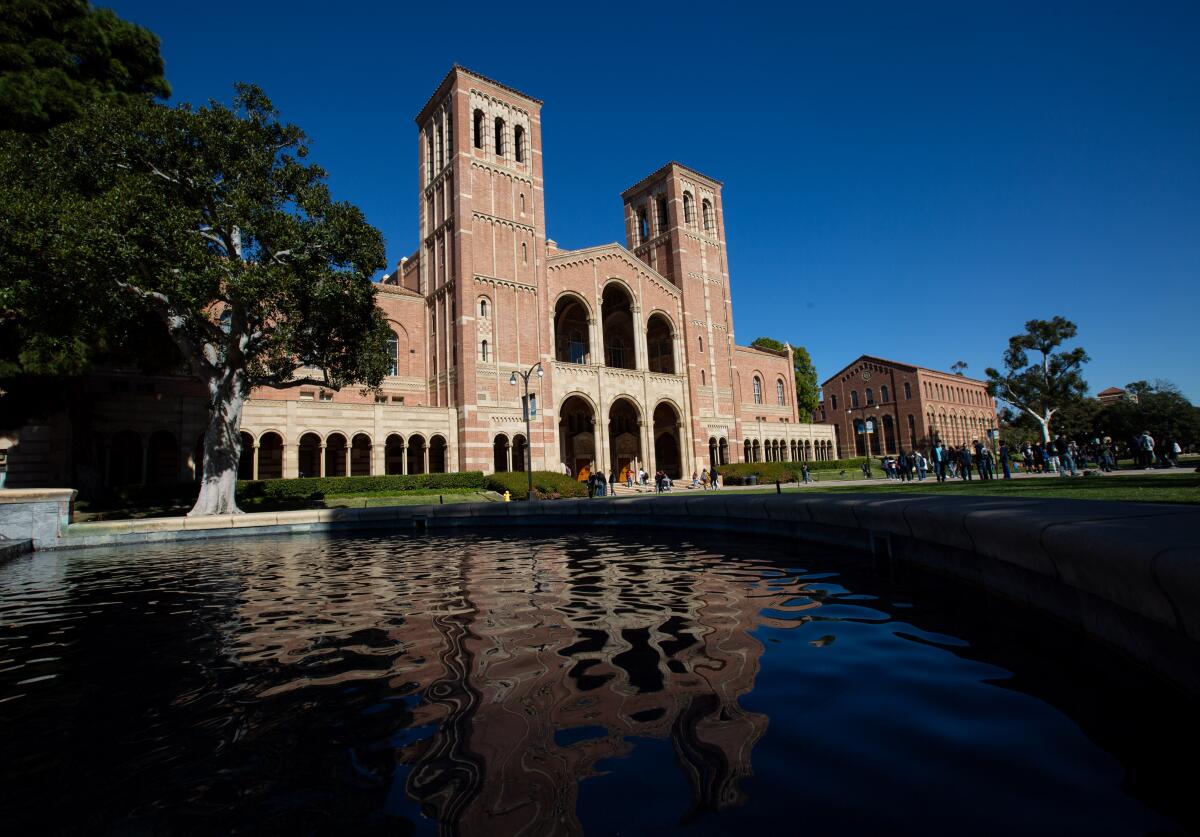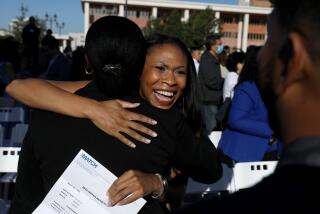UC’s record-smashing applications put long-held diversity goals within reach

The University of California’s record-shattering applications for fall 2021 show remarkable surges in Black, Latino and other underrepresented students seeking admission, putting the system within reach of dismantling long-standing admission barriers and building a student body that reflects the state’s diversity.
UCLA and UC Berkeley, the system’s two most selective campuses — where diversity particularly tumbled after affirmative action was banned in public schools more than two decades ago — achieved historic gains, according to preliminary UC data released Thursday. Black freshman applicants rose by about 48% at both campuses, and Latino applicants increased by 33% at UCLA and 36% at Berkeley.
Overall, UC’s nine undergraduate campuses drew a record number of applicants despite myriad pandemic challenges, totaling 249,855, a 16.1% leap over last year. Among Californians, Black freshman applicants increased by 21.8%. Latinos — who have made up the largest proportion of in-state students seeking freshman seats since 2013 — rose by 12.2%. Asian Americans increased by 10.7%, whites by 18.8%, Pacific Islanders by 23.9% and American Indians by 5.5%.
“These are phenomenal numbers and speak to the ability of UC to attract students from across the state and country at a time of incredible turbulence,” said Ted Mitchell, president of the American Council on Education, which represents more than 1,700 colleges and universities. “The university has sought a more representative class for a long time and now it’s within reach.”
He added that universities have long used the excuse that they lack diversity because they can’t attract enough applicants. But UC has proved otherwise.
Shaun R. Harper, a USC education professor who heads the campus Race and Equity Center, said that UC will need to do much more than increase the number of diverse applicants.
“The critical next steps are to actually admit, enroll and graduate them,” Harper said. “Public research universities prepare many of our state’s scientists and innovators. When UC campuses fail to equitably enroll and graduate Black and Latino students, they ultimately deny California the chance to realize its full economic potential. Denying access to brilliant students who reflect the diversity of our state harms us all.”
UC campus officials credited the gains to the elimination of standardized testing requirements, active recruitment in underserved areas, and community partnerships to identify and prepare students as early as middle school for the academic rigor needed for a competitive application.
UCLA, for instance, works with alumni, churches, community groups and L.A. Unified schools to identify high- performing students in underserved neighborhoods and support them for college. The campus also deploys UCLA students into the community to provide teens with tutoring, guidance and role models, helping them envision themselves as Bruins.
“The entire UCLA community takes seriously our responsibility as a public institution to make sure that all students, regardless of their backgrounds ... have an opportunity to be prepared for and apply to UCLA,” said Youlonda Copeland-Morgan, vice provost for enrollment management.
Nearly 139,500 students applied to UCLA for freshman seats, a 28% increase over last year as it maintains its spot as the most popular university in the nation. The campus saw significant gains across other racial and ethnic groups in addition to Black and Latino applicants: 35% for whites; 22% for Asian Americans; 34% for Pacific Islanders and 16% for American Indians. Asians were the largest group of applicants, followed by Latino, white and Black students.
UC Berkeley also has made major gains in diversity over the last two years under Olufemi “Femi” Ogundele, director of undergraduate admissions. Berkeley’s fall 2020 freshman admitted class was its most ethnically diverse in more than 30 years.
UC Irvine was the most popular campus for California applicants who are the first in their families to attend college, making up 47% of those seeking admission.
The double-digit application growth comes despite challenges created by the COVID-19 pandemic. After high schools shut down, shifting to online instruction, many students struggled to achieve the traditional hallmarks of a strong college application: high grades in rigorous AP and honors courses, distinctive extracurricular activities and competitive SAT and ACT test scores. The pandemic also disrupted college counseling, which was more difficult to arrange online than dropping by the school’s counseling office for face-to-face meetings.
UC’s gains are in line with the 16% increase in applications at large universities that are among the 900-plus private and public campus members of the Common Application, a nonprofit organization. Smaller campuses, however, saw a 3.5% decline in applications, according to Common App Chief Executive Jenny Rickard.
Rickard said 85% of the organization’s campuses dropped standardized testing requirements or made the tests optional amid the pandemic, a move she agrees fueled the surge. UC dropped the requirements entirely for fall 2021 applicants under a court order issued in litigation involving students with disabilities. So far, UCLA, UC Santa Cruz, UC Merced and UC Davis have said they plan to remain test-free next year as well.
One unexpected effect of the pandemic is that students had more time to complete college applications because they were “stuck at home all day,” said Ruth Garcia, a Downtown Magnets High School senior. She said some of her friends told her they would not have applied to UC campuses otherwise.
“They couldn’t do community service. They weren’t out doing this or that club or basketball practice,” said Lynda McGee, a Downtown Magnets college counselor. “So they had time to get their applications finished.”
Systemwide, applications from California Community College transfer students increased by 7.5%. UC applications also rose among students who are low-income and the first in their families to attend college, bucking a national decline in those groups.
Even as UCLA hailed the gains, however, Copeland-Morgan said the university plans to slightly reduce the size of the incoming 2021 class as it completes a five-year growth plan. Last year, the campus offered admission to 15,600 of 109,000 freshman applicants, the system’s lowest admission rate at about 14%. Application decisions, which are due out by April 1, will be based on 13 factors with a special eye toward demonstrations of academic rigor, Copeland-Morgan said.
“We have an abundance of amazing students to choose from,” she said.
More to Read
Sign up for Essential California
The most important California stories and recommendations in your inbox every morning.
You may occasionally receive promotional content from the Los Angeles Times.











